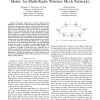Free Online Productivity Tools
i2Speak
i2Symbol
i2OCR
iTex2Img
iWeb2Print
iWeb2Shot
i2Type
iPdf2Split
iPdf2Merge
i2Bopomofo
i2Arabic
i2Style
i2Image
i2PDF
iLatex2Rtf
Sci2ools
INFOCOM
2009
IEEE
2009
IEEE
Minimizing End-to-End Delay: A Novel Routing Metric for Multi-Radio Wireless Mesh Networks
—This paper studies how to select a path with the minimum cost in terms of expected end-to-end delay (EED) in a multi-radio wireless mesh network. Different from the previous efforts, the new EED metric takes the queuing delay into account, since the end-to-end delay consists of not only the transmission delay over the wireless links but also the queuing delay in the buffer. In addition to minimizing the end-to-end delay, the EED metric implies the concept of load balancing. We develop EEDbased routing protocols for both single-channel and multi-channel wireless mesh networks. In particular for the multi-radio multichannel case, we develop a generic iterative approach to calculate a multi-radio achievable bandwidth (MRAB) for a path, taking the impacts of inter/intra-flow interference and space/channel diversity into account. The MRAB is then integrated with EED to form the metric of weighted end-to-end delay (WEED). As a byproduct of MRAB, a channel diversity coefficient can be de...
| Added | 24 May 2010 |
| Updated | 24 May 2010 |
| Type | Conference |
| Year | 2009 |
| Where | INFOCOM |
| Authors | Hongkun Li, Yu Cheng, Chi Zhou, Weihua Zhuang |
Comments (0)

